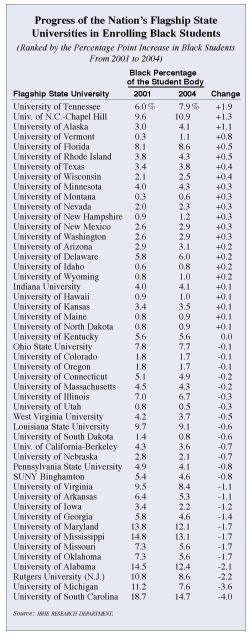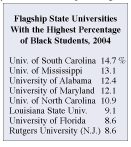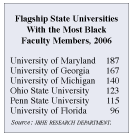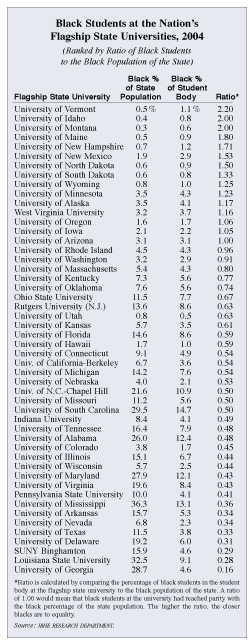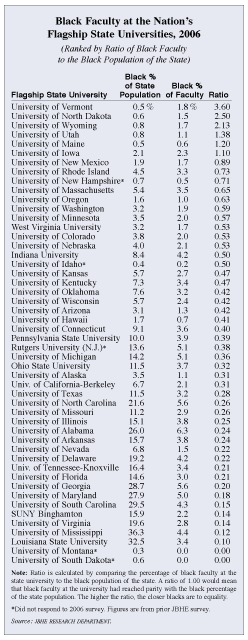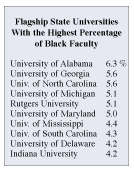| JBHE Completes Its Count of Black Students and Faculty at the Nation's 50 Flagship State Universities Five years ago JBHE reported on the progress of our nation's flagship state universities in enrolling black students and hiring black faculty. We now revisit the issue and have found a somewhat mixed bag of results in black student enrollments and a generally encouraging trend in black faculty levels.Much of the data contained in the pages of JBHE concerns the status and progress of black students at the nation's highest-ranked colleges and universities. Our emphasis on these institutions has a purpose. We believe that tracking the progress of blacks at the elite institutions is a potent measurement of racial progress in the nation as a whole. It is these universities that turn out the business, education, and political leaders of tomorrow. It is our belief that blacks will never be in a position to achieve racial equality in the United States until they are able first to achieve racial parity at our nation's most prestigious institutions of higher education.
There is a further point. This is that the elite schools tend to lead others. State universities, in particular, are deeply conscious of what goes on at the most selective institutions. In most cases they will adopt racial policies similar to those used at the highly ranked schools. The down-to-earth importance of public universities to the overall progress of African Americans cannot be overlooked for very pragmatic reasons. About 80 percent of all black students currently enrolled in undergraduate higher education in the United States attend state-operated institutions. The most important, and often largest, of these institutions is the state's flagship university. Each of the 50 states has a higher educational institution that it has designated as its flagship public university. These schools are usually quite large with enrollments at some institutions nearing 50,000. In most cases these universities are large research institutions that grant undergraduate, master's, professional, and doctoral degrees. Also, some of these public universities, such as the University of Virginia, the University of Michigan, the University of California at Berkeley, and the University of North Carolina at Chapel Hill, are among the nation's highest-ranked universities. According to our research, the earliest black graduate of any flagship state university appears to be Isaiah G. DeGrasse, who received a bachelor's degree in 1836 from Newark College (now the University of Delaware). It appears that no other black person graduated from any flagship state university until after the Civil War. During the 1870s a small number of black students graduated from flagship state universities in Michigan, South Carolina, Vermont, and Wisconsin. The flagship state university that was the last to confer a bachelor's degree on a black student appears to be the University of Alabama in 1965, or perhaps the University of Florida that same year. Black Enrollments Today In many states today there are still significant admissions barriers for black students. These include bans on race-sensitive admissions in California, Washington, and Florida. Admissions requirements such as minimum SAT test scores or minimum high school grade point averages also present major barriers to black enrollments at flagship universities in some states. Of course these requirements are not racially discriminatory on their face. But nevertheless these standards do make it difficult for large numbers of black students to gain admittance to some publicly operated flagship universities.
There are other barriers to black enrollments at flagship state universities: • In many southern states, high school guidance counselors, teachers, and principals continue to funnel black students to the predominantly black universities in these states. • Money can also be an obstacle for black students at flagship campuses. Often the flagship campus will have higher fees and tuition than other state-operated colleges and universities. African-American students tend to come from lower-income families and therefore may prefer to enroll at a university or a community college where they can earn a degree at a much lower cost. • In many states the flagship campus may be located in a rural area far from major black population centers. This can have a major dragging effect on the level of black enrollments due to travel time and expenses as well as the absence of black cultural, religious, and commercial organizations in these rural, predominantly white settings. A prime example is Pennsylvania State University located in the town of State College in the rural, central part of Pennsylvania. This is about halfway between the two major black population centers in Pittsburgh and Philadelphia. Blacks are only 4 percent of the 35,000 undergraduate students at Penn State, considerably less than one half the level of blacks in the college-age population in Pennsylvania.
Despite these solid barriers to enrollment at the nation's flagship state universities, nationwide, tens of thousands of black students are currently enrolled at these institutions. Therefore, it is important to track the progress of black students at the flagship universities. It is also vital to see how these universities are performing in their efforts to attract black faculty. It is widely believed that one of the best ways to attract black students is to increase the number of black faculty teaching on campus. In the following pages, JBHE offers the results of our latest research on the current status of black students and black faculty at these institutions. Many of our readers will be surprised to hear that the flagship state university with the highest percentage of black students is the University of South Carolina. Nearly 15 percent of the student body at the University of South Carolina is black. The University of Mississippi, the University of Maryland, and the University of Alabama now have student bodies that are more than 12 percent black. This is tremendous progress in view of the fact that no blacks were allowed on these campuses 40 years ago. However, we must note that black enrollments at these universities is still less than one half the level that would prevail if blacks were enrolled at a rate equal to their percentage of the college-age population in each state. The progress at flagship state schools in Alabama, Maryland, Mississippi, and other states is not replicated at many other flagship universities in the South. For example, today, only 4.6 percent of the student body at the University of Georgia is black. This is about the same level of black enrollments as was the case in 1980. At the University of Arkansas, black enrollments have actually declined over the past quarter-century. In 1980, 5.7 percent of the students at the University of Arkansas were black. Today that percentage is only 5.3 percent. In 1980, 5.6 percent of the student body at the University of Tennessee was black. By 2001 black enrollments had inched up only to 6.0 percent of the total. In recent years the University of Tennessee has made a concerted effort to attract black students. Scholarships funded by the new state lottery have made attending the University of Tennessee more affordable for low-income blacks. By 2004 blacks made up 7.9 percent of the enrollments at the University of Tennessee. This was the best progress achieved by any flagship state university over the 2001 to 2004 period.
The University of North Carolina at Chapel Hill and the University of Alaska were the only other state universities in our survey where black enrollments increased by more than one percentage point during the four-year period. Over the four-year span, 23 flagship universities showed an increase in the black percentage of their total enrollments. The University of Kentucky stayed the same at 5.6 percent black while 26 flagship universities showed a decline in black enrollments. The University of South Carolina, which, as stated above, has the highest percentage of black enrollments, also had the largest percentage point decline over the latest four-year period. In 2001 blacks were 18.7 percent of the student body. In 2004 the percentage of black undergraduates dipped to 14.7 percent. At the University of Alabama, the University of Michigan, and Rutgers University, the black percentage of the student body dropped by more than two percentage points from 2001 to 2004. Clearly, the mandated revamping of the un-dergraduate admissions program at the University of Michigan as a result of the 2003 Gratz Supreme Court case and the surrounding publicity had a dampening effect on black undergraduate enrollments at the university. Comparing Black Enrollments to Black Population Simply ranking the states by their percentage of black students does not give an accurate picture of a state's commitment to racial diversity. While, as noted above, there has been significant progress in the racial diversification of the University of Mississippi, the university still has a very long way to go before the black percentage of its student body reaches parity with the percentage of blacks in the state's population. Therefore, we suggest that the most effective way to measure the relative success in the racial integration of a flagship state university is to compare the black percentage of the student body at these schools with the black percentage of the state's population. Using this approach, we find that 14 of the nation's 50 states actually have a higher percentage of blacks enrolled at their flagship state university than they have blacks in their total state population. Expectedly, almost all of these states have very small black populations. However, it is still worth noting the fact that despite the small numbers of blacks in these states, their flagship state universities appear to be taking steps to ensure that their black residents are getting a chance to participate on an equal basis in public higher education. When we compare the percentage of blacks enrolled at a particular flagship university in relation to the percentage of blacks in the state population, Vermont leads the list. In fact, the percentage of blacks enrolled at the University of Vermont is more than twice the percentage of blacks in the state. At the University of Idaho and the University of Montana, the percentage of black enrollments is double the percentage of blacks in the state population. The other 11 states in which the percentage of black enrollments at their state flagship university exceeds the percentage of blacks in the state are Maine, New Hampshire, New Mexico, North Dakota, South Dakota, Wyoming, Minnesota, Alaska, West Virginia, Oregon, and Iowa. In Arizona the percentage of blacks enrolled at the state university is the same as the black percentage of the population. Not to be discounted is the fact that many of the flagship universities in these states actively recruit black students for football and men's and women's basketball from out of state. For example, there were 75 black students at the University of Wyoming in 2004, 32 of them were scholarship athletes. It is not known how many of these athletes were recruited from out of state but it is likely that many of them are not Wyoming natives. Thus, the presence of out-of-state black athletes at these institutions may play a major role in the fact that they sit near the top of the rankings when we compare black enrollments at flagship state universities to the black enrollment of the state population.
Among states with a significant percentage of blacks in the population, the University of Oklahoma ranks very high. Blacks make up 5.6 percent of the student body at the University of Oklahoma. This is only slightly less than the percentage of blacks in the state. Also ranking high are the states of Massachusetts, Ohio, and Kentucky. Among the states in the Deep South, Florida has the best record. Blacks make up nearly 8.6 percent of the students enrolled at the University of Florida. This is compared to a black population that makes up 14.6 percent of the state's total. In contrast, the performance of the University of Georgia is the worst in the nation. Blacks make up 4.6 percent of the student body at the University of Georgia. This is only about one sixth of what racial parity would call for considering the fact that blacks make up 28.7 percent of the population in Georgia. Arkansas, Texas, Mississippi, Louisiana, and Delaware also have very low scores when we compare black enrollments at the flagship state university to the black population of the state. Black Faculty at the Nation's Flagship Universities Now we turn to the number of black faculty at the nation's 50 flagship universities. A few highlights: The University of Maryland has 187 blacks on its faculty, the most of any of the nation's premier state universities. Ohio State University, the University of Michigan, Pennsylvania State University, and the University of Georgia are the only other flagship state universities that have more than 100 black faculty members. At the other extreme, in 2001 the University of South Dakota and the University of Montana had no black faculty members whatsoever. This year both universities declined to respond to the JBHE survey, so we can only guess that they have no good news to report on this front. The University of Hawaii, the University of Alaska, and the University of Maine each have fewer than 10 black faculty members. Actual numbers of black faculty members may be deceiving because there are huge differences in the size of the flagship state institutions. Therefore, a more meaningful way to compare these institutions regarding their black faculties is to see what percentage of their total faculties are black. Using this measurement, we find that the University of Alabama has the highest percentage of black faculty among the flagship state institutions at 6.3 percent. Nationwide, black college and university professors make up about 5 percent of all faculty members. However, if we exclude black faculty who teach at historically black colleges and universities, the percentage of black faculty at the nation's predominantly white institutions is about 4 percent. In addition to the University of Alabama, nine flagship state universities have a percentage of black faculty that is higher than the national average for all predominantly white colleges and universities. They are Indiana University, Rutgers University, the University of Michigan, the University of North Carolina at Chapel Hill, the University of Delaware, the University of Georgia, the University of Maryland, the University of South Carolina, and the University of Mississippi.
Comparing Black Faculty to the Black Population It may come as a surprise to the reader that the percentage of black faculty was the highest at the University of Alabama, one of the last flagship state universities to integrate its student body. Yet, when one considers the fact that more than 26 percent of the population of the state of Alabama is black, an African-American faculty of a mere 6.3 percent is not an extraordinary accomplishment. Therefore, we believe that a far more useful ranking of the flagship state universities is to compare their percentage of black faculty to the percentage of blacks in the population, and thus the work force of a given state. Under this ranking system, the University of Alabama is near the bottom of the list, not the top. There are six state flagship universities at which the percentage of black faculty is greater than the percentage of the black population in the state. All of these six states have small black populations. They are Vermont, North Dakota, Wyoming, Maine, Iowa, and Utah. Among the states with a significant black population of greater than 5 percent, the University of Massachusetts ranks the highest when we compare the level of black faculty to the black population of the state. Blacks make up 3.5 percent of the faculty at UMass whereas blacks are 5.4 percent of the state's population. Among the southern and border states, Kentucky has the most favorable ratio of black faculty at its state flagship university to the black population of the state. Louisiana State University ranks at the bottom among the southern states. In a state where the black population exceeds 32.5 percent of the total, only 3.4 percent of the faculty at LSU is black. | |




